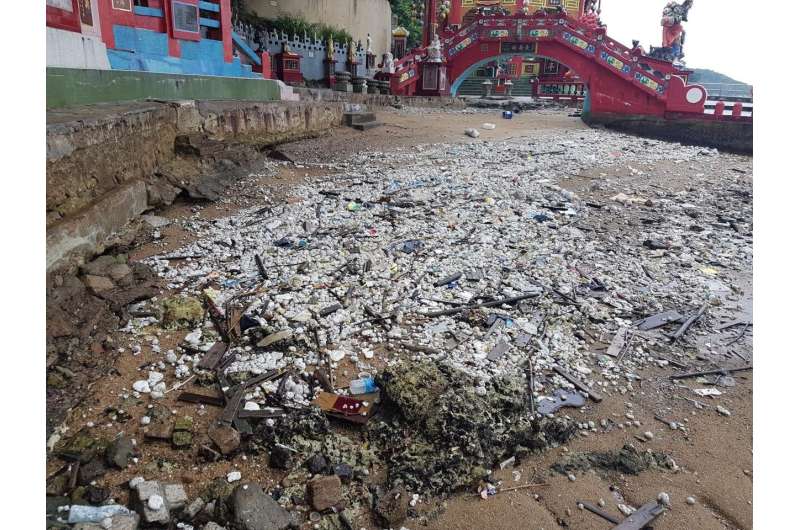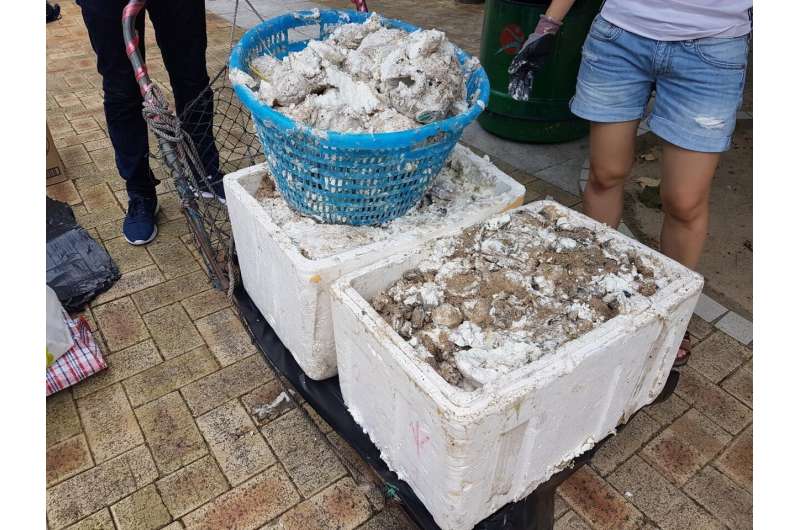Ecological impacts of palm stearin spill to the coastal ecosystem

In August 2017, a marine accident occurred in the Pearl River Estuary where a cargo vessel accidentally released about 1,000 tonnes of palm stearin into the sea. Over 200 tonnes of palm stearin reached the southwest coasts of Hong Kong. The general public and green groups expressed concerns that such palm oil pollution could adversely affect the marine life and marine ecosystem, yet there was a lack of scientific information on the toxicity of the palm stearin toward marine organisms in the scientific literature, making it impossible to accurately evaluate its ecological risk.
Subsequently, Professor Kenneth Leung Mei Yee from School of Biological Sciences and the Swire Institute of Marine Science, The University of Hong Kong (HKU) and his research team launched a comprehensive 18-month investigation on the degradation, bioaccumulation, and toxicity of the palm stearin through both field- and laboratory-based investigations. The study sites included Hung Shing Yeh Beach, Deep Water Bay, Repulse Bay, Chung Hom Kok, Outer Tai Tam and Inner Tai Tam. The results of the study were published in the international journal Environmental Science & Technology.
The results of the field-based study showed that the palm stearin could dissolve in seawater and sediment under elevated temperature, and marine organisms could be contaminated by the oil. In early August 2017, samples of the tissues of marine gastropod species, seawater and sediment were found to have high level of fatty acids, especially C16:0 fatty acid which is dominant in the palm stearin.
After the incident, the Hong Kong SAR Government and local citizens made concerted efforts in removing the palm stearin from the impacted shores. Such important actions effectively stopped their further contamination and helped to minimise negative impacts brought by the palm stearin.

In November 2017 (i.e. four months after the incident), the concentration of fatty acids in both seawater and sediment samples returned to natural levels. Nonetheless, the concentration of fatty acids remained high in marine gastropods; this might be due to a natural cause that the animals intensified their uptake of food to store more energy for winter.
The results of the laboratory experiment suggested that the rates of disintegration and degradation of palm stearin were very slow. After deploying the palm stearin in seawater for a year under laboratory conditions, only about 10% of the palm stearin could be disintegrated and degraded.
After studying the toxicity of palm stearin on 10 different marine species, the research team also revealed that palm stearin posed notable adverse effects on pelagic planktons and zooplanktons. It could prohibit the growth of microalgae (e.g. diatoms) and cause mortality to pelagic copepods, rotifers and brine shrimps. Benthic copepod and marine medaka fish were more tolerant to palm stearin. Although the fish could eat palm stearin, their growth was inhibited. Reproduction of the benthic copepod was greatly reduced after exposure to palm stearin.
Combining the above findings, the research team conducted a scientific ecological risk assessment. The results indicated that the ecological risk was very high right after the accidental spill in August 2017 (risk quotient [RQ] at all sites >> 1). Fortunately, the ecological risk was substantially reduced after 4 months following the incident (RQ < 1 in four sites; RQ < 2 in the other two sites).
The results of this study highlight the importance of the immediate action for removal of palm stearin from the shores, because such actions minimise long-term impact to the marine environment. As there is an ever-increasing trend of marine trade, the number and frequency of marine accidents are expected to rise. This study, therefore, provides useful scientific information to authorities around the world for them to make informed decision in risk assessment and management of similar crises in future.
More information: Guang-Jie Zhou et al, Accidental Spill of Palm Stearin Poses Relatively Short-Term Ecological Risks to a Tropical Coastal Marine Ecosystem, Environmental Science & Technology (2019). DOI: 10.1021/acs.est.9b04636
Journal information: Environmental Science & Technology
Provided by The University of Hong Kong


















